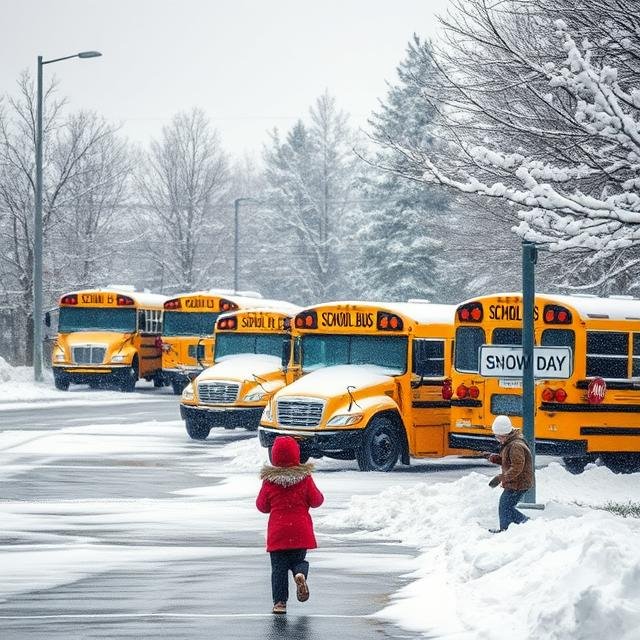In West Michigan, winter storms are more than just a seasonal inconvenience—they have the power to shape the school calendar. Parents, students, and educators are all familiar with the anticipation that builds as snow begins to fall, wondering whether the next morning will bring an announcement of a snow day. While technology and forecasting tools have made predicting closures more reliable, there is still a level of uncertainty. This article dives into the details of West Michigan school closing predictions, explaining what goes into these decisions, how predictions are made, and how communities prepare for the unexpected.
Table of Contents
Why School Closings Matter in West Michigan
West Michigan experiences some of the heaviest snowfall in the state due to lake-effect snow from Lake Michigan. Districts across the region, from Grand Rapids to Muskegon and Holland to Kalamazoo, often face unpredictable and rapidly changing winter weather conditions.
School closures are not just about missing a day of class. They have real impacts on:
- Safety – The foremost concern is student and staff safety. Icy roads, poor visibility, and severe cold can make travel hazardous.
- Academics – Missed school days can push back lessons, testing schedules, and even the end of the school year.
- Family logistics – Parents often need to make last-minute arrangements for childcare when schools close unexpectedly.
- Economics – Businesses may see increased absenteeism when parents stay home to supervise children.
Because of these wide-ranging effects, accurate school closing predictions are highly valued in West Michigan communities.
How Predictions Are Made
While no one can guarantee an exact forecast of school closures, there are patterns and tools that improve predictions. School officials and meteorologists work with several factors:
1. Weather Forecasts
Meteorologists at local stations like WOOD TV8 and FOX 17 provide detailed updates, especially on snow totals, wind chills, and ice accumulation. Heavy snow combined with below-zero wind chills often leads to closures.
2. Road Conditions
Superintendents rely on input from local road commissions and police departments. If plows are struggling to keep up or ice remains untreated, closures become more likely.
3. Timing of the Storm
Snowfall at night or early morning has a greater impact on school schedules compared to storms that end before dawn. Predictions often hinge on whether plows have enough time to clear roads before buses start running.
4. Temperature and Wind Chill
In West Michigan, dangerously low wind chills can be just as significant as snow totals. Schools often close when wind chills drop below -20°F, as this can cause frostbite within minutes for students waiting at bus stops.
5. District-Specific Policies
Not all districts close under the same conditions. For example, rural areas with longer bus routes may cancel classes more quickly than urban districts where students close under the same conditions. For example, rural areas with longer bus routes may cancel classes more quickly than urban districts where students live closer to schools.
The Role of Technology in School Closing Predictions
Technology has transformed the way parents and students anticipate snow days.
- Weather Apps & Alerts – Apps like Weather Underground, AccuWeather, and local news apps provide real-time storm tracking.
- Social Media – Districts now use Twitter, Facebook, and Instagram to communicate decisions instantly.
- Prediction Tools – Websites and social media accounts sometimes use algorithms or patterns to “predict” school closings based on weather models, though these are unofficial.
- Machine Learning Models – Some forecasting services experiment with AI to cross-analyze past closures with current conditions, increasing the accuracy of predictions.
While technology has made predictions faster and more detailed, the final decision still rests with school administrators, who must balance student safety with educational needs.
Historical Patterns of Closures in West Michigan
By looking at past years, patterns emerge that help with West Michigan school closing predictions.
- Lake-effect snow events are the most common reason for closures. Cities like Muskegon and Holland often see more snow days than inland areas.
- Polar vortex events in recent years caused multiple days of closures across all districts due to extreme cold.
- January and February tend to have the highest likelihood of closures, though early-season storms in November and late snowfalls in March also contribute.
Tracking these historical patterns helps communities and meteorologists make informed predictions about when closures are most likely.
Impact on Learning and Community
While many students cheer when a snow day is announced, educators recognize the challenges closures present.
- Virtual Learning Options – Some West Michigan districts adopted e-learning or “remote snow days” during the COVID-19 pandemic, which allows education to continue even when schools are closed physically.
- Rescheduling – Michigan law requires schools to meet a minimum number of instructional days. Excessive closures can mean extending the school year into June.
- Community Resilience – Snow days also highlight the adaptability of families, as communities often rally together to help one another when unexpected closures occur.
Looking Ahead: Predictions for the Future
The climate in West Michigan is shifting, and with it, the frequency and intensity of storms. Some years bring record-breaking snowfalls, while others see relatively mild winters. Climate variability makes predictions more complex.
However, one thing is certain: school closing predictions will continue to be a central part of winter life in West Michigan. As forecasting technology improves, communities will likely see more accurate predictions, but the unpredictability of Midwest weather ensures that some surprises will remain.
Conclusion
School closures in West Michigan are not random decisions. They involve careful consideration of weather forecasts, road conditions, student safety, and historical patterns. While technology and predictive models have made it easier to anticipate closures, the unpredictable nature of lake-effect snow and extreme cold ensures that families must always be prepared.
Understanding West Michigan school closing predictions allows parents, students, and educators to plan ahead, balancing the excitement of snow days with the practical challenges they bring.
FAQs About West Michigan School Closing Predictions
Q1: Who decides when schools in West Michigan close?
A: The final decision is made by the district superintendent, often after consulting with transportation directors, road commissions, and weather forecasts.
Q2: Why do some districts close while others stay open?
A: Local geography, bus routes, and road conditions differ. Rural areas may experience worse travel conditions than urban centers.
Q3: How accurate are online snow day prediction websites?
A: They can be fun to follow but are not official. They base predictions on patterns but do not replace superintendent decisions.
Q4: Do West Michigan schools always close for extreme cold?
A: Many districts close when wind chills drop below -20°F, though the exact threshold varies.
Q5: Will e-learning replace snow days in the future?
A: Some districts already use remote learning for snow days, but others maintain traditional closures. The trend may grow as digital access improves.

